 Author: Joey Wan
Author: Joey Wan  August 20,2022
August 20,2022
Currently, the various materials we have available are PVC, rubber, TPE and high quality cross-link materials, but unfortunately there are rubber cables rated at 90°C, and even PVC cables rated at 70°C .
It is also often used outdoors, which obviously will greatly affect the service life of the system.

For photovoltaic applications, materials for outdoor use should be based on UV, ozone, severe temperature changes and chemical attack. The use of low-grade materials under such environmental stresses will result in brittle cable jackets and even break down the cable insulation.
All of these conditions directly increase the loss of the cable system, as well as the risk of short-circuiting the cable and, in the medium to long term, the possibility of fire or personal injury.
The solar cable is an electron beam cross-link cable, rated at 120°C, which can withstand harsh weather conditions and mechanical shock in the equipment it belongs to.
According to the international standard IEC216, RADOX® solar cable, in outdoor environment, its service life is 8 times that of rubber cable and 32 times that of PVC cable. These cables and components not only have the best weather resistance, UV resistance and ozone resistance, but also withstand a wider range of temperature changes (eg from –40°C to 125°C).

Why is the solar photovoltaic cable linked to the solar photovoltaic panel? Why do you have to use the product of solar photovoltaic cable?
We all know that the current era is the era of solar energy, and it is impossible to make all human beings happy only by hydropower generation. The only places that rely on hydroelectric power generation are coastal areas or areas with a huge drop in the plateau.
In Africa, many places are dry all year round.
The sun shines so much that it makes it difficult for crops to grow, which naturally affects the economy.
Things are two-sided, and Africa has one of the best sunlit zones in the world. Making full use of the advantages of solar light will bring earth-shaking changes to the lives and economic development of African people.
To deal with the potential hazards caused by high temperatures, manufacturers tend to use double-insulated rubber-jacketed cables. However, standard versions of these cables are only permitted for use in environments with a maximum operating temperature of 60°C. In Europe, the temperature that can be measured on the roof is as high as 100°C.
The solar cable is rated at 120°C (20,000 hours of use). This rating equates to 18 years of use at a continuous temperature of 90°C; longer life when the temperature is below 90°C. Generally, the service life of solar equipment is required to reach more than 20 to 30 years.
For these reasons, the use of dedicated solar cables and components in solar energy systems is highly desirable.
